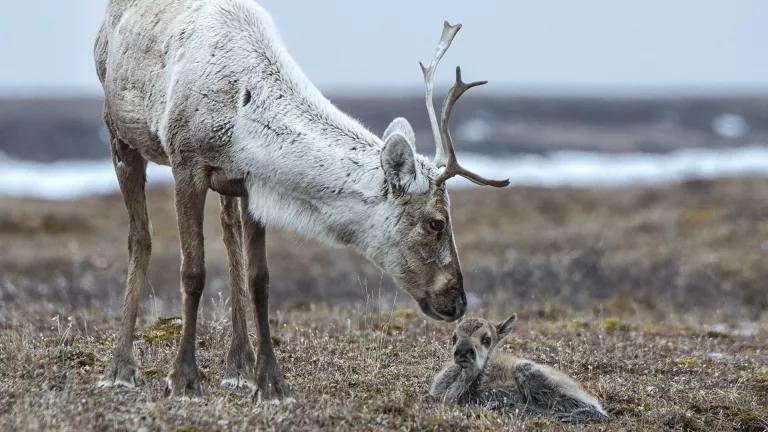Happy Birthday to the Arctic Refuge—and May it Live Forever
Just this week, the Trump administration set a date to auction off the heart of these lands. This will not stand.

A caribou (Rangifer tarandus) mother and her newborn calf from the Porcupine herd
Peter Mather/Minden Pictures
Sixty years ago, on December 6, 1960, Public Land Order 2214 established a National Arctic Wildlife Range. Industry and environmental interests had been feuding over the fate of the region since the late 1920s, as military and business leaders wanted the land for oil and gas exploration. But one year after Alaska became a state, PLO 2214, signed by Secretary of the Interior Fred Seaton, set aside 8.9 million acres in northeastern Alaska.
Then in 1980, Congress passed a law that President Jimmy Carter signed to expand and protect from development this majestic swath of land in northern Alaska, preserving its wildlife, its untrammeled beauty, and its age-old cultural importance to Indigenous peoples. The Alaska National Interest Lands Conservation Act (ANILCA) created America’s largest preserve, the Arctic National Wildlife Refuge—a place whose 1.5 million–acre Coastal Plain is sacred to the Gwich’in people.
This largely untouched natural ecosystem is truly a wonder—rich with polar bears, musk oxen, fish, 200 species of birds, and other precious wildlife. It’s also a calving ground for the Porcupine caribou, which are critical to the sustenance and cultural tradition in Gwich’in villages.
But polluters have been desperate to get at it for decades, pushing to drill for, and profit from, oil that may lie below this sensitive coastal tundra.

The coastal tundra of the Arctic National Wildlife Refuge
Steve Hillebrand/USFWS
Congress sought to develop it under President Bill Clinton, but he vetoed the measure. And there were close calls, stirring controversy, under both Presidents George H. W. Bush and George W. Bush.
But the public pushed back, and the area has endured.
In 2015, President Obama strengthened protections for it. But just two years later, Congress made another, somewhat duplicitous, play for it—foisting a provision to mandate Arctic Refuge leasing into the tax bill, and enabling the Trump administration’s large-scale giveaway to polluters.

Neetsa’ii Gwich’in leader Sarah James at the Arctic Village
The Gwich’in Steering Committee, the Iñupiat land protectors, and other Indigenous representatives, along with a broad coalition of groups, including NRDC, have fought the Trump administration at every turn as it has barreled forward to lease these sacred lands to oil companies.
The administration rushed out a sham of an environmental review last year, and just months ago issued a record of decision to begin leasing.
NRDC and partners sued in federal court, asking to set aside the administration’s environmental review and decision on the grounds that they violate the National Environmental Policy Act, the Endangered Species Act, the National Wildlife Refuge System Administration Act, and the Administrative Procedure Act.
Which brings us to this week when, in a breathless effort, the administration, knowing the Biden administration will reverse course, set a lease sale for January to make all of this happen under the wire.
Grifters gonna grift. But at a time when temperatures in the Arctic are rising twice as fast as the rest of the planet, and energy markets are in a glut around the globe, this cannot stand. Trump’s Bureau of Land Management was wrong in downplaying the damage this would do to the Arctic tundra and permafrost—and the entire ecosystem the refuge supports.
On this 60th birthday, we #StandWithTheGwichin in calling to #ProtectTheArctic. May this glorious place, in all of its splendor, live forever.



